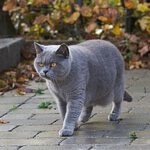The British Shorthair is the pedigreed version of the traditional British domestic cat, with a distinctively stocky body, thick coat, and broad face. The most familiar colour variant is the “British Blue”, with a solid grey-blue coat, pineapple eyes, and a medium-sized tail. The breed has also been developed in a wide range of other colours and patterns, including tabby and colourpoint.
It is one of the most ancient cat breeds known. In modern times, it remains the most popular pedigreed breed in its native country, as registered by the UK’s Governing Council of the Cat Fancy (GCCF). A quarter of all kittens registered with the GCCF each year are British Shorthairs, making the British the most popular pedigree cat in the UK.
The breed’s good-natured appearance and relatively calm temperament make it a frequent media star, notably as the inspiration for John Tenniel’s famous illustration of the Cheshire Cat from Alice in Wonderland. The Cat Fanciers’ Association profile reads: “When gracelessness is observed, the British Shorthair is duly embarrassed, quickly recovering with a ‘Cheshire cat smile’.”
History
Researchers are not sure how cats first reached the British Isles. In many other parts of Europe cats became common at the same time as the spread of the Roman Empire, however it appears that housecats reached the British Isles before the Romans did.
These cats then interbred with the local European wildcat population. Over the centuries, their naturally isolated descendants developed into distinctively large, robust cats with a short but very thick coat, to better withstand conditions on their native islands. Based on artists’ representations, the modern British Shorthair is unchanged from this initial type.
